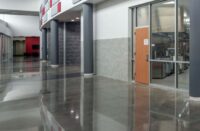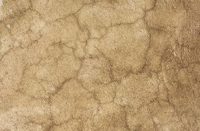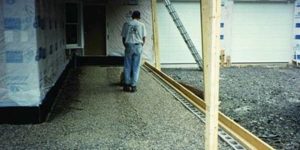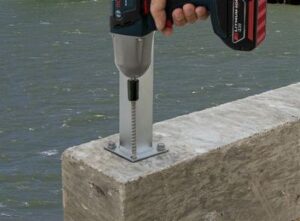 Cracks are to concrete what death and taxes are to life — inevitable.
Cracks are to concrete what death and taxes are to life — inevitable.
But at least cracks can be repaired.
If and how a crack gets repaired prior to a decorative concrete application depends both on the nature of the topping to be applied and on the nature of the crack.
Static cracks v. moving cracks
Hairline cracks generally fall into the static crack category — they don’t move and they’re not going to. They’re typically surface cracks that were caused by one-time events, like drying shrinkage. Tight, static, surface cracks can be coated with most polymer-modified cementitious overlays and never seen again. However, if these same hairline cracks are on a floor that’s acid-stained, they may go from practically invisible to far more noticeable if the stain sinks in and darkens them. This could be seen as a desired effect, but it could also be seen as a blunder.
Sealers, tinted or otherwise, can also inadvertently highlight the hairline cracks in a floor in an unattractive way. “The risk is, the sealer flows down into the crack and leaves a little sink area, and when light shines across it, it accentuates the crack,” says Seth Pevarnick, a technical field consultant specializing in decorative concrete for Ardex Engineered Cements. “In that situation, when it just a hairline, I’d just leave it go. Yeah, you may see it when you mop it, but when it dries you don’t see it anymore.”
When a crack is continuing to lengthen, or when the each side of the cracked slab moves independently of the other, you’ve got what’s known as a moving crack, aka a structural crack. Any crack that cuts clear through a slab, whether it seems to be moving or not, ought to be considered a structural crack.
Structural cracks are usually pretty easy to spot,” says Tim Cutright, a dealer advisor for PermaCrete. “You’ll get chipping around them, or one part of the slab will be slightly lower than the other part, or you’ll be able to see dirt and gravel in the crack itself — that’s a dead giveaway.”
Sometimes, though, determining whether you’re dealing with a surface crack or a structural crack is a bit of a guessing game — though one you can get to the bottom of.
“If you had a small crack in the surface and you weren’t sure what it was, I would take a Skilsaw with a mason’s blade, and I’d cut down about one-sixteenth of an inch and see if it bottoms out,” says Cutright. “If it bottoms out, it’s a surface crack.”
Moving cracks demand to be repaired prior to doing a decorative overlay. “If you don’t do anything to a moving crack and you go over it with an overlay, that crack is almost guaranteed to transmit back up through the overlay,” says Dan Cook, president of CemTec Systems. “And once it’s transmitted up through there, if you continue to get movement, it can pinch the overlay and cause delamination.”
Basic crack-repair procedure includes widening and smoothing out the edges of a crack, either with a chisel or a crack-chasing saw; thoroughly cleaning out the crack; applying a primer, if your crack repair material calls for it; then applying the crack repair material.
Three types of repair material
Crack repair materials range from rubbery caulks that you can stretch with your fingers to steely acrylics that you can’t drive a nail through. New crack repair materials come onto the market all the time. But basically they all fall into three categories: flexible, semi-rigid and rigid.
Flexible crack repair materials are typically used in joints and in structural cracks that move like joints. They stretch and compress as a crack moves, and they do nothing to restrict that movement. While flexibles don’t technically “repair” cracks in the sense of bonding them together, they’re great for weatherproofing. They’re disastrous beneath a cementitious overlay, but they are sometimes used beneath some non-cementitious elastomeric coatings.
They might work with an elastomeric topping, but with a cementitious overlay you’re almost guaranteed to get a crack,” says Ed Diaz, senior technical service specialist with Sika Corporation. Flexibles can typically be found in a wide range of colors.
Epoxy-based crack repair materials are the industry standard for reducing or eliminating a crack’s ability to move.
Rigid epoxies are used for structural repairs where the concrete needs to be solidly fused back together, returning the cracked concrete to its monolithic state. Rigid materials make repaired cracks stronger than they were before they cracked. They can be troweled in, like other crack repair materials, or applied with a low-pressure injection system. Injection systems require specialty equipment, and often a specialty contractor, but they offer the best guarantee that a crack will never crack again. Crack injection is the standard approach for structural repairs.
Semi-rigid epoxies are most widely used for repairing cracked concrete for decorative applications, and they’re commonly used beneath cementitious overlays. Semi-rigids allow for rapid turnarounds on crack repairs, as well as repairs that are perfectly flush with the floor, since excess cured material can be shaved off. They allow for a slight amount of crack movement, though hopefully not enough to reflect through the overlay. Some semi-rigid crack repair systems incorporate a fiberglass mesh layer, which is bonded to the top of the crack. It helps to disburse any movement in the crack, to reduce the likelihood it will telegraph through the overlay.
Old cracks, new control joints
Simply stopping or restricting a crack’s movement does nothing to address the underlying cause of the crack and doesn’t insure that the crack won’t continue cracking or reappear nearby. But short of calling in a structural engineer and undertaking an expensive slabjacking, slurry-pumping repair, there is a simple and crucial way to hedge your bets: cut control joints. With a new control joint in place a few inches away from a repaired crack, any future cracking will be directed along the bottom of the control joint. Hopefully.
It’s standard practice to cut control joints near cracks repaired with either semi-rigid or rigid epoxies. “If you don’t relieve the stress somewhere near that crack, you’ll develop another crack somewhere near your repair, and that will show up through the overlay,” says Ron Cottingham of Dayton Superior.
Control joints are especially critical near cracks repaired with rigid materials, since the welded crack allows no movement whatsoever. “If you had a pencil that snapped, and you Superglued those two pieces back together and then tried to break that pencil again, it won’t break in that crack — it will break somewhere else,” Cottingham says.
Cutright recommends waiting to cut control joints until the repair material has cured. “You never know what’s going on with the substrate, and if you start cutting control joints prior to repairing the crack, you may possibly exacerbate any cracking problems the concrete has,” he says.
Honoring the joints
Any joint in the slab, of course, needs to be honored through the cementitious overlay. Once that saw cut is in place, other purely decorative saw cuts may be used to conceal the functioning joints in a decorative pattern.
The joints themselves can be made with an angled cut using a V-shaped diamond crack-chasing blade. “More often than not that’s the tool of choice in decorative,” says Tom Roe, director of the concrete/masonry cutting division for Multiquip, which markets crack-chasing equipment as well as concrete saws capable of handling crack-chaser blades. “It gives you a nice beveled look — anywhere from 30 to 45 degrees on both sides — that’s very attractive.”
Typically a thinner, square-edge blade will be used to cut the initial joints while the topping is still green. After the concrete cures, the wider V-blade is used to finish the joint. “Green concrete is very abrasive, and some of the aggregate might not necessarily be set up in the cementitious material,” Roe says. “If you were go in with a wide blade too soon, oftentimes what you’re going to do is create spalling that’s very unacceptable aesthetically.”
Coloring crack fillers
If a particular crack repair material will take any stain at all, it won’t stain the same way as the surrounding concrete. So if the idea is to make the crack disappear, an overlay is generally used.
However, integral colors can be used with some repair materials to match them to the surrounding concrete. “You can use standard powder pigments, but you have to do some sort of mock-up phase to find out what the proper pigment loading is,” says Diaz. “We have cases where we’ve actually done some historical repairs and have needed to match weathered concrete that way. It’s possible to match colors pretty closely.”
When a crack appears in a cementitious overlay, a patching compound made by the overlay manufacturer is often the best bet for a seamless repair. Patching compounds are often un-sanded versions of an overlay material. They can be feathered onto the topping and color-matched, integrally or with stain.
No guarantees
One thing you should never do to a crack is warranty the repair. There’s simply no way to guarantee that a crack won’t be back. But the return of a crack doesn’t mean a repair was all for naught. “A crack may come back, but it’s going to be less severe and hopefully less noticeable,” says Cook. “The crack that comes back to the top is usually a hairline crack that a lot of people can live with. It’s not so unsightly.”















